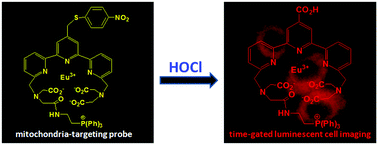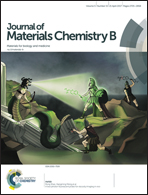A mitochondria-targeting time-gated luminescence probe for hypochlorous acid based on a europium complex†
Abstract
Bioresponsive luminescence probes based on lanthanide complexes have shown great utility in a variety of time-gated luminescence bioassays. However, functional lanthanide complexes that can target individual organelles for probing biospecies therein have rarely been investigated. In this work, a unique Eu3+ complex, Mito-NPSTTA-Eu3+, was designed and synthesized as a probe for the time-gated luminescence sensing of HOCl inside the mitochondria of living cells. The probe showed a fast, highly sensitive and selective luminescence response to HOCl with a wide available pH range (pH 3–10), and highly specific mitochondria-localization performance. Taking advantage of time-gated luminescence bioimaging and the excellent properties of the Eu3+ complex, the generation of endogenous HOCl in RAW 264.7 cells and the uptake of exogenous HOCl by zebrafish were successfully imaged, respectively. The results demonstrated the feasibility of Mito-NPSTTA-Eu3+ for the imaging of mitochondrial HOCl, and validated the potential of our strategy for the design of lanthanide complex-based organelle-targeting bioresponsive probes.



 Please wait while we load your content...
Please wait while we load your content...